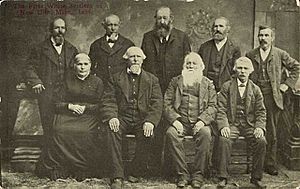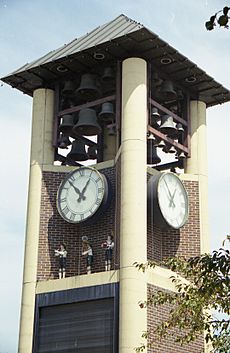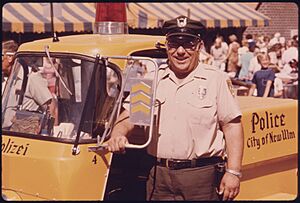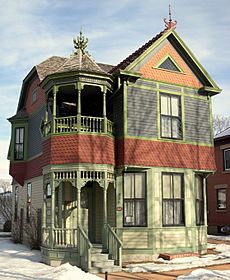New Ulm, Minnesota facts for kids
Quick facts for kids
New Ulm
|
|
|---|---|
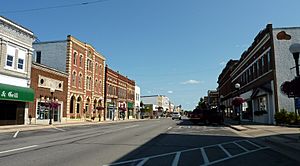
Downtown New Ulm
|
|
| Motto(s):
"A City of Charm And Tradition"
|
|
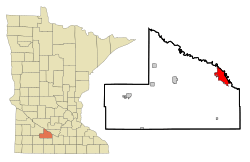
|
|
| Country | United States |
| State | Minnesota |
| County | Brown |
| Named for | Ulm, Germany |
| Government | |
| • Type | Mayor – Council |
| Area | |
| • Total | 10.29 sq mi (26.66 km2) |
| • Land | 10.16 sq mi (26.31 km2) |
| • Water | 0.14 sq mi (0.36 km2) |
| Elevation | 896 ft (273 m) |
| Population
(2020)
|
|
| • Total | 14,120 |
| • Density | 1,390.31/sq mi (536.78/km2) |
| Time zone | UTC-6 (Central (CST)) |
| • Summer (DST) | UTC-5 (CDT) |
| ZIP code |
56073
|
| Area code(s) | 507 |
| FIPS code | 27-46042 |
| GNIS feature ID | 2395217 |
| Website | ci.new-ulm.mn.us |
New Ulm is a city in Brown County, Minnesota, United States. It is the main city of the county. In 2020, about 14,120 people lived there. New Ulm is located where the Minnesota River and the Cottonwood River meet.
The city is famous for its strong German heritage. You can find the Hermann Heights Monument, Flandrau State Park, and the historic August Schell Brewing Company here. It is also home to the Minnesota Music Hall of Fame. New Ulm has many historical places from the US-Dakota War of 1862.
Contents
History of New Ulm
How New Ulm Was Settled
New Ulm was started in 1854 by a group called the German Land Company of Chicago. They named the city after Ulm, a city in southern Germany. Ulm and Neu-Ulm in Germany are like "twin cities." Because of its German roots, New Ulm became a major place for brewing beer in the Upper Midwest. The August Schell Brewing Company is located here.
In 1856, another group, the Settlement Association of the Socialist Turner Society, helped New Ulm grow. Turners were German gymnasts who believed in a "Sound Mind, Sound Body." After a failed revolution in Germany in 1848, many Germans moved to the United States. They formed Turner clubs across the country.
These Turners wanted to build a community that followed their ideals. They joined the Chicago Germans in New Ulm, bringing money and many new settlers in 1856.
The city's design showed the Turner ideals. The German Land Company hired Christian Prignitz to plan New Ulm in 1858. This plan showed a big vision for the city. In the center were areas for Turner Hall, the county courthouse, and a public school. These were the main places for politics, social life, and education. Streets were named after American heroes like George Washington and Benjamin Franklin. People were also given land outside the city for gardens. This helped them support themselves and live in harmony with nature.
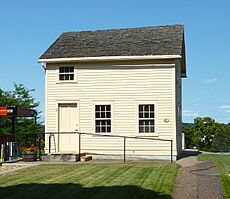
The U.S.–Dakota War of 1862
The US-Dakota War of 1862 began on August 18, 1862. It started with an attack near the Lower Sioux Indian Reservation, about 30 miles from New Ulm. The very next day, New Ulm was attacked by a group of Mdewakanton warriors. The townspeople quickly formed a militia and built defenses around the city center.
The Dakota returned with more fighters on August 23. Volunteers from other towns, led by Charles Eugene Flandrau, arrived to help. Even though they were outnumbered, the defenders of New Ulm fought off the attack again. Most of the town outside the defenses was burned. Only 49 buildings were left for about 2500 people. Because of little shelter, low ammunition, and sickness, most people moved to Mankato on August 25.
The 1881 Tornado
On July 15, 1881, a large tornado hit New Ulm. Six people died, and 53 were hurt.
New Ulm During World Wars
Before the United States joined World War I in 1917, people in New Ulm watched events in Europe closely. Local newspapers sometimes shared news from relatives in Germany. In April 1917, New Ulm voters were against joining the war.
When the U.S. entered the war, the government worked to stop anti-war feelings. Minnesota's governor also took action. State groups watched for people who seemed to be against the war. They also watched immigrants and people of German heritage. This was because some thought they might be more loyal to Germany.
On July 25, 1917, about 10,000 people gathered at Turner Hall for a rally. They protested sending American soldiers to other countries. Government agents watched the crowd and collected information.
A month later, the governor removed New Ulm's mayor and city attorney from their jobs. A college director was also pressured to leave his job. These actions caused a big split in the community. Many residents felt it was an attack on their German heritage. Others, especially local business owners, worried about money problems. They supported pro-war parades and fundraising.
During World War II, German prisoners of war (POWs) were kept in a camp near New Ulm. This area is now Flandrau State Park.
Historic Places to Visit
Turner Hall
New Ulm Turner Hall was built in 1873. It is the oldest Turner Hall in the United States that is still used for its original purpose. The building has been updated over the years. Turner Hall is still very active today. Its Rathskeller (a type of basement bar) might be the oldest bar in Minnesota that has been open continuously. Its gymnastics program is also the oldest in the state. The Rathskeller has murals of German scenes painted by different artists.
Brown County Historical Society
The Brown County Historical Society is located at 2 North Broadway. It has three floors of exhibits. It also has one of the largest collections of historical records in Minnesota. You can find over 5,500 family files and many old records there.
Defender's Monument
The Defender's Monument is at Center and State Streets. The State of Minnesota built it in 1891. It honors the people who defended New Ulm during the Dakota War of 1862. A local artist named Anton Gag created the artwork at the bottom of the monument.
Hermann Monument
The Hermann Monument in New Ulm is a huge statue on a hill. It looks over the Minnesota River valley and the city. It was inspired by a similar monument in Germany. The statue became a symbol for members of the Sons of Hermann. This was a group for German Americans.
In 1885, Sons of Hermann groups across the country decided to build a monument. It would represent their German culture. Thanks to the Sons of Hermann groups in Minnesota, the monument was built in New Ulm. Many German immigrants lived there. The sculptor was Alfons Pelzer from Ohio.
German Bohemian Monument
There is a monument in New Ulm that honors German-Bohemian immigrants to America. It was built in 1991 by the German-Bohemian Heritage Society. Most of these immigrants came to the area by boat on the Minnesota River. They were mostly Catholic farmers who spoke a German dialect.
The names of over 350 immigrant families are carved into granite slabs around the base of the monument. Many of these names are still common in the area today. As more immigrants arrived, some settled in New Ulm and nearby towns.
The bronze statue on top of the monument was made by Leopold Hafner. He is a German-Bohemian sculptor who lives in Germany. The monument is located at 200 North German Street and is open all year.
Culture and Fun
Glockenspiel in Schonlau Park
New Ulm has a special glockenspiel. It is one of the few free-standing bell towers in the world. It is 45 feet tall. Its largest bell weighs 595 pounds, and all the bells together weigh two tons. The bells play a tune to tell the time.
Minnesota Music Hall of Fame
The Minnesota Music Hall of Fame opened in New Ulm in 1990. This museum shows off music items from all over Minnesota.
Polka Capital of the Nation
Music has always been important in New Ulm. This was especially true after musically talented people from Germany arrived in the 1870s.
Musicians like Whoopee John Wilfahrt became famous for "Old-Time" music. Other local bands, such as those led by Harold Loeffelmacher and Fezz Fritsche, also became well-known. They even made popular recordings.
In the 1940s, new ballrooms opened, and the KNUJ radio station started. New Ulm then called itself the "Polka Capital of the Nation." New Ulm's Polka Days festival was famous worldwide. It was held every July. Polka bands played on Minnesota Street, and people danced and enjoyed themselves late into the night.
Festivals and Celebrations
New Ulm hosts yearly events that celebrate German culture. These festivals feature German food, music, and beer.
- New Ulm's Oktoberfest has been celebrated since 1981. It takes place on the first two weekends in October.
- Bock Fest started in 1987 at the August Schell Brewing Company. It often happens around the same time as Fasching, a German carnival celebration.
- Bavarian Blast is a summer festival. It is a new version of New Ulm's older festival, Heritagefest.
Geography and Climate
New Ulm covers about 10.26 square miles. Most of this is land, and a small part is water. The Minnesota River and the Cottonwood River flow by the city. They eventually join the Mississippi River.
New Ulm has four distinct seasons. Summers are usually warm to hot, with thunderstorms. Winters are quite cold and snowy.
People of New Ulm
| Historical population | |||
|---|---|---|---|
| Census | Pop. | %± | |
| 1860 | 635 | — | |
| 1870 | 1,310 | 106.3% | |
| 1880 | 2,471 | 88.6% | |
| 1890 | 3,741 | 51.4% | |
| 1900 | 5,403 | 44.4% | |
| 1910 | 5,648 | 4.5% | |
| 1920 | 6,745 | 19.4% | |
| 1930 | 7,308 | 8.3% | |
| 1940 | 8,743 | 19.6% | |
| 1950 | 9,348 | 6.9% | |
| 1960 | 11,114 | 18.9% | |
| 1970 | 13,051 | 17.4% | |
| 1980 | 13,755 | 5.4% | |
| 1990 | 13,132 | −4.5% | |
| 2000 | 13,594 | 3.5% | |
| 2010 | 13,522 | −0.5% | |
| 2020 | 14,120 | 4.4% | |
| U.S. Decennial Census | |||
In 2002, a report showed that about 65.85% of people in New Ulm have German ancestors. This is more than in any other city in the U.S.
In 2010, there were 13,522 people living in New Ulm. Most residents (97.8%) were White. About 25.7% of households had children under 18. The average age in the city was 41.4 years.
Media and News
Newspapers
The Journal is a daily newspaper in New Ulm. It started in 1898.
Radio Stations
New Ulm has two main radio stations. KNUJ (860 AM) plays farm-related programs. KATO-FM (93.1 FM) plays country music from Mankato.
Getting Around New Ulm
The Hermann Express provides bus service in the city six days a week.
Major roads in New Ulm include U.S. Highway 14 and Minnesota State Highways 15 and 68.
New Ulm is also served by a train line from the Union Pacific company.
Famous People from New Ulm
Many interesting people have connections to New Ulm:
- David Rysdahl (born 1987), an actor.
- Ali Bernard (born 1986), an Olympic wrestler in 2008.
- Kathryn Adams Doty (born 1920), an actress. She was married to Hugh Beaumont from the TV show Leave It to Beaver.
- Marion Downs (born 1914), an audiologist who helped create hearing tests for newborns.
- Wanda Gág (born 1893), a famous author and artist. You can visit her childhood home.
- Tippi Hedren (born 1930), an actress who starred in Alfred Hitchcock's films The Birds and Marnie.
- John Lind (born in Sweden), was the 14th governor of Minnesota from 1899 to 1901. He later served in the U.S. Congress.
- Harold Loeffelmacher (born 1905), a polka band leader. He started The Six Fat Dutchmen in New Ulm.
- Brad Lohaus (born 1964), a retired professional basketball player.
- August Schell (moved to New Ulm in 1848), started the August Schell Brewing Company.
- Flip Schulke, a photojournalist who traveled with Martin Luther King Jr..
- Terry Steinbach (born 1962), a former baseball player for the Oakland A's. He was a three-time All-Star.
- Lenore Ulric (born 1892), a famous actress and movie star.
- Whoopee John Wilfahrt (born 1893), a polka band leader. He led one of the most successful polka bands in the nation.
International Connections
New Ulm is a "sister city" with:
See also
 In Spanish: New Ulm (Minnesota) para niños
In Spanish: New Ulm (Minnesota) para niños


